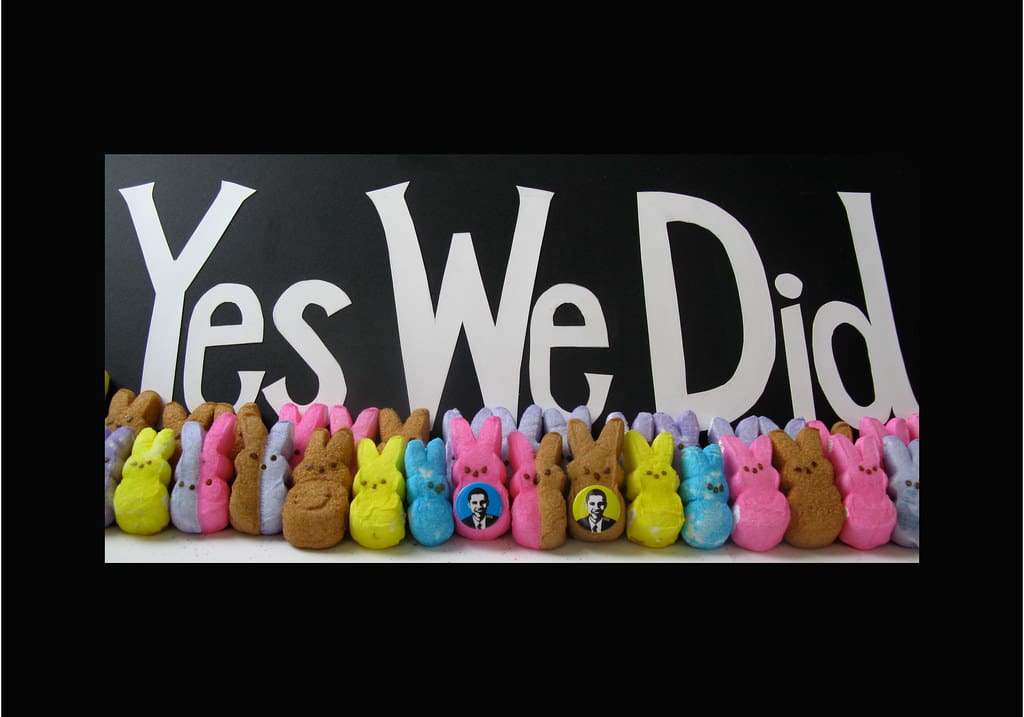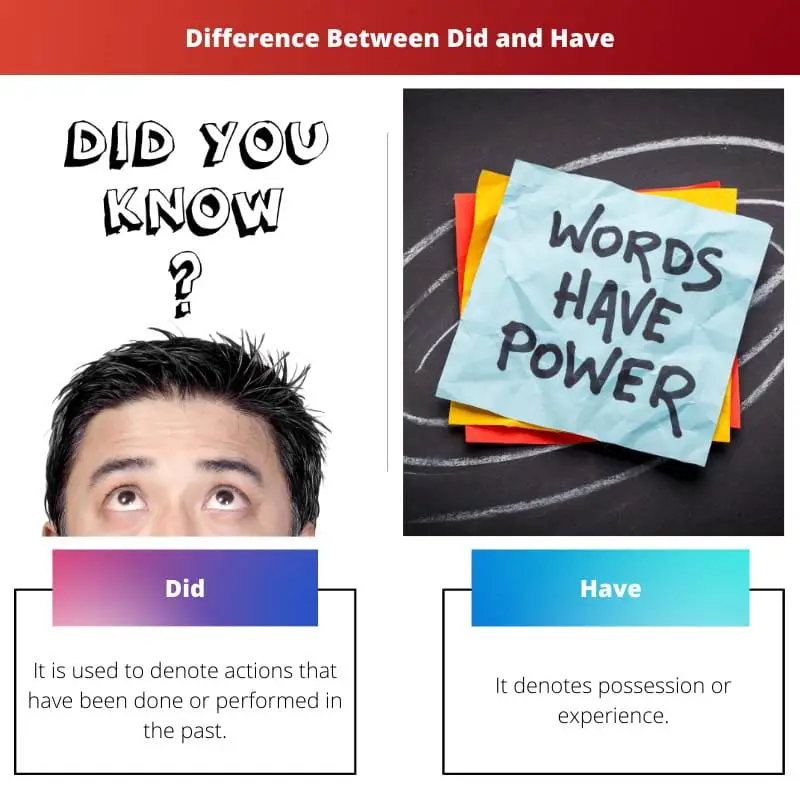“Did” is the past tense of the verb “do” and is primarily employed to form questions and negative statements in the past. For instance, “Did you complete your homework?” or “She did not attend the meeting.”
On the other hand, “have” is a versatile verb that can function as a main verb or auxiliary verb. When used as an auxiliary verb, “have” is often paired with a past participle to create perfect tenses, indicating actions or states that occurred before the present moment. Examples include “I have finished my work” or “They have lived here for years.”
Key Takeaways
- ‘Did’ is the past tense of ‘do,’ and is used to indicate a completed action in the past, while ‘have’ indicates possession or represents the present perfect tense.
- ‘Did’ is used with the base form of the verb, while ‘have’ is used with the past participle.
- ‘Did’ is also used in questions and negative sentences to form the simple past tense, while ‘have’ is used to form the present perfect tense.
Did vs Have
The difference between and have lies in their usage. Did is the past form of doing and thus used in sentences accordingly. Have is a kind of verb known as an auxiliary verb used in forming sentences in the present perfect tense.

The word “did” is used simply as the past form of the verb “do”, which is used to denote things in the past. It states actions that have been done previously or in the past.
The word “have” denotes or can denote a lot of things. It can denote possession or an experience. It is mainly used to form sentences in the present perfect form.
Comparison Table
| Feature | Did | Have |
|---|---|---|
| Function | Auxiliary verb (helps form past tense questions and negative statements) | Main verb (expresses possession, obligation, or completed action) |
| Tense | Past tense | Present tense, past tense (have/had) |
| Use in Questions | Forms yes/no questions and Wh- questions in the past tense | Not used alone in questions (used with “do” in present tense questions) |
| Use in Negative Statements | Used with the main verb to create negative statements in the past tense | Used with “not” to create negative statements |
| Examples | * Did you eat breakfast? * They did not go to the party. | * I have a cat. * We had dinner early. |
What is Did?
The term “did” is a past tense auxiliary verb in the English language, primarily used to form questions and negative statements in the past. It plays a crucial role in expressing actions or events that have already occurred.
Basic Usage
Formation
In its basic form, “did” is the past tense of the base verb “do.” It is employed to construct questions and negatives, indicating actions or states that happened in the past. For example:
- Affirmative: She did her homework.
- Negative: She did not finish her assignment.
- Question: Did you visit the museum?
Emphasis and Contrast
“Did” can also be used for emphasis or to contrast information. In such cases, it is often stressed in speech to highlight a particular action or event:
- I did tell him to be careful.
Interrogative Sentences
Information Seeking
When forming questions, “did” is often employed at the beginning of the sentence, followed by the base form of the main verb. This structure is common for seeking information about past actions:
- Did they attend the meeting?
Tag Questions
“Did” is frequently utilized in tag questions to confirm information or seek agreement:
- You finished your work on time, didn’t you?
Negative Sentences
Denying Actions
In negative sentences, “did not” (or its contraction “didn’t”) is used to deny or negate a past action:
- She did not enjoy the movie.
Contractions
The contraction “didn’t” is commonly used in informal speech and writing:
- He didn’t complete the assignment on time.
Emphatic Statements
Stressing Actions
In emphatic statements, “did” is employed to emphasize a particular action, often accompanied by stress or additional words:
- I did finish the project before the deadline.

What is Have?
“Have” is a versatile and essential verb in the English language, serving various grammatical functions across different contexts. Its usage extends beyond a simple action verb, encompassing auxiliary, modal, and causative roles.
Grammatical Functions of “Have”
1. Primary Verb Usage: Possession and Ownership
As a main verb, “have” denotes possession and ownership. For example, “I have a car” expresses ownership of a vehicle. This primary function is crucial in constructing sentences that convey possession.
2. Auxiliary Verb: Perfect Tenses
“Have” functions as an auxiliary verb to form perfect tenses. In constructions like “She has completed the project,” the verb “has” indicates a completed action with relevance to the present.
3. Modal Verb: Necessity and Obligation
In certain contexts, “have” takes on a modal role, expressing necessity or obligation. For instance, “You have to finish your homework” implies a mandatory requirement.
4. Causative Verb: Inducing an Action
When used causatively, “have” indicates causing someone to do something. For instance, “I had my car repaired” signifies arranging for the repair rather than doing it personally.
5. Expressions of Experience: Have + Object + Verb (Infinitive)
The verb “have” is employed to describe experiences, such as “I had my hair cut.” In this structure, the object follows “have,” and the verb appears in the infinitive form.
6. Expressions of Relationships: Have + Object + Adjective
“Have” is also used in expressions describing relationships, where the object is followed by an adjective. For example, “She had her guests feeling welcome.”

Main Differences Between Did and Have
- Usage:
- “Did” is used in the past simple tense to form questions and negatives, and it is also used for emphasis.
- “Have” is used in various tenses, such as present perfect, past perfect, and future perfect, to indicate an action that started in the past and has a connection to the present or future.
- Tense:
- “Did” is primarily associated with the simple past tense.
- “Have” is used in various tenses, including present perfect (“have/has done”), past perfect (“had done”), and future perfect (“will have done”).
- Formation:
- “Did” is the past tense form of the verb “do.” It is used with the base form of the main verb.
- “Have” is a helping verb that is used with the past participle of the main verb to create different tenses.
- Emphasis:
- “Did” is often used for emphasis or to clarify a point in a sentence.
- “Have” is used to express experiences or actions that are relevant to the present or future.
- Examples:
- Did: “Did you finish your homework?”
- Have: “I have visited that museum before.”
- Questions and Negatives:
- “Did” is commonly used to form questions and negatives in the past tense.
- “Have” is used to form questions and negatives in various tenses, including present perfect and past perfect.
- Connection to Present:
- “Did” focuses on a specific action or event in the past.
- “Have” connects the past action to the present, indicating a relevance or impact on the current situation.
- Common Expressions:
- “Did” is commonly used for short and specific actions or events in the past.
- “Have” is used in expressions like “have done,” “have seen,” or “have been,” indicating experiences or actions with a connection to the present.




